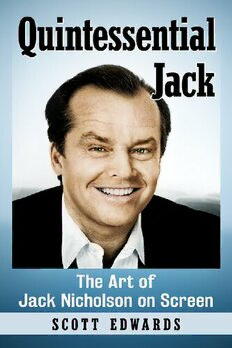
Quintessential Jack: The Art of Jack Nicholson on Screen PDF
Preview Quintessential Jack: The Art of Jack Nicholson on Screen
Quintessential Jack This page intentionally left blank Quintessential Jack The Art of Jack Nicholson on Screen S E COTT DWARDS McFarland & Company, Inc., Publishers Jefferson, North Carolina Photographs are from the collection of the author unless credited otherwise. LIBRARYOFCONGRESSCATALOGUING-IN-PUBLICATIONDATA Names: Edwards, Scott, 1960–author. Title: Quintessential Jack : the art of Jack Nicholson on screen / Scott Edwards. Description: Jefferson, North Carolina : McFarland & Company, Inc., Publishers, 2018 | Includes bibliographical references and index. Identifiers: LCCN 2017052749 | ISBN 9781476670942 (softcover : alk. paper) ♾ Subjects: LCSH: Nicholson, Jack—Criticism and interpretation. Classification: LCC PN2287.N5 E39 2018 | DDC 791.4302/8092—dc23 LC record available at https://lccn.loc.gov/2017052749 BRITISHLIBRARYCATALOGUINGDATAAREAVAILABLE ISBN (print) 978-1-4766-7094-2 ISBN (ebook) 978-1-4766-3086-1 © 2018 Scott Edwards. All rights reserved No part of this book may be reproduced or transmitted in any form or by any means, electronic or mechanical, including photocopying or recording, or by any information storage and retrieval system, without permission in writing from the publisher. On the cover: Jack Nicholson in Heartburn, 1986 (Paramount Pictures/Photofest) Printed in the United States of America McFarland & Company, Inc., Publishers Box 611, Jefferson, North Carolina 28640 www.mcfarlandpub.com Acknowledgments There are many people who have honored me with their inspiration, without whose contributions and assis- tance this book could not have been possible: My mother and father, both of whom passed away during its writing. My older brother, Kenny, now gone for 16 years, who shared and fueled my early obsession with film. And my younger brother, Michael, who now keeps the family going with me. Love and support from Natalie. Encouragement and enthusiasm for the craft of writing from friend David Stuart, author of Jane at the Fair: The Adventures of Calamity Jane at the 1901 Pan- American Exposition. The confidence to try from Diane di Prima (directed specifically to me) and Ray Bradbury (as part of a group). Special thanks to Mews Small for the behind- the- scenes photo shown in the Preface and to Emily Corey for permission to quote from and show her father’s notes found in the Jeff Corey Collection at the Ohio State Uni- versity. Appreciation to Rich Maurer for his sonic foren- sics to uncover additional content in recorded interviews. Gratitude to all who took their time to provide interviews and insight, in particular Mews Small, Gary Kent, Michael Margotta and Dr. Brooke Cannon. v This page intentionally left blank Table of Contents Acknowledgments v Preface 1 1. The Actor as Auteur 5 2. Heroes and Villains 29 3. Men on a Mission 50 4. Pieces of Schmidt 65 5. A More Perfect Union 75 6. The School of Roger 90 7. As Cuckoo as It Gets 100 8. Hippies and Hogs and Horses 120 9. From Ballbusters to Heart Attacks 138 10. The Developing Delinquent 146 11. Writers on the Storm 155 12. Rom- Com Wonder 176 13. Misfits and Misanthropes 193 14. The Dicks Versus the Hoods 204 15. Head Trips 220 16. The Occasional Filmmaker 248 Chapter Notes 267 Bibliography 275 Index 283 vii This page intentionally left blank Preface “This project will be a little tough to get off the ground.”1 —JackNicholson’sagent,SandyBressler Mr. Bressler was correct. But 12 years and 100,000 words later, this book belongs to you, the reader. Quintessential Jack: The Art of Jack Nicholson on Screen presents the most comprehensive study of the actor’s career that is neither a story of the man’s life nor a Films of… approach, but rather an in- depth examination of roles, acting style and technique, and screen persona, as well as the films’ thematic links. Every film is represented, organized into chapters that correlate the types of characters (such as disaffected youth or men trapped in a fatalistic cycle); compare and contrast movie archetypes (heroic roles vs. the villainous); examine the portrayal of the human condition (the depiction of those suf- fering from mental illness); and follow common messages and themes (sexual freedom and anti- consumerism). The fluid nature of the book’s structure, liberated from a film- by-film chronological format, allows for an enriching exploration of seemingly dis- parate men. For instance, a shared dedication to duty, honor and a higher organizational calling bring Colonel Jessep from A Few Good Men into the same orbit as Jimmy Hoffa from the Danny DeVito biopic and ACLU lawyer George Hanson from Easy Rider. To help collect even the most incongruent characters together in this way, a literary device brings the men of a given chapter together in the same physical space at the same time to introduce them within that chapter. Jessep and Hoffa and Hanson are in one place at one time. They coexist physically just as they coexist via shared character traits. Four or five Nicholson characters might be in the same diner or jailhouse or some other related setting. This cinematic device underscores the inter- section of multiple movie worlds and provides a creative entrée to the idea that is presented in a particular chapter. 1
